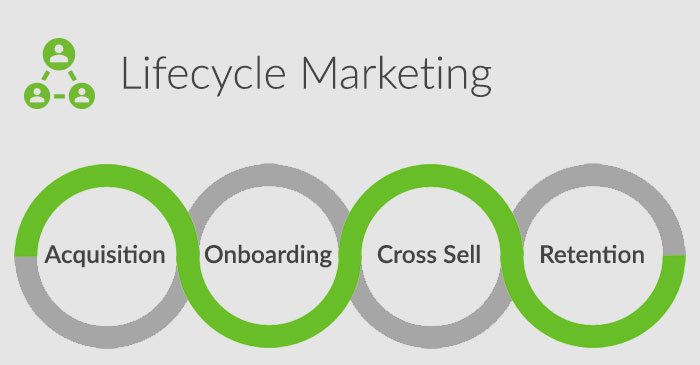It is well known that continuing to engage account holders is crucial to achieving ongoing goals for loans, deposits etc. It’s also no secret that is typically much easier and costs less to cross-sell existing account holders new products and services than it is to acquire brand new relationships. Lifecycle marketing is an on-going, integrated approach for banks and credit unions to continue to build relationships with the existing account holders from the moment they join the financial institutions.

By strategically leveraging data, financial marketers are able to activate marketing tactics at every stage of the consumer journey. This allows marketers to predict what an account holder may need or want even before they know it and send relevant cross-sell offers accordingly. A consumer’s journey can often be determined by the initial offer that converted a prospect, and from there the relationship-building and nurturing process can begin to grow that account holder into a long-lasting, loyal customer. Lifecycle marketing enables marketers to optimize their media and communication dollars and deliver messages and recommendations based on account holders’ preferences and needs in real-time.
This approach proved critical in 2020 as COVID-19 increased the need for customer retention, brand value creation and content marketing. Lifecycle marketing gives financial institutions a cadence of engaging with their account holder with relevant and timely communications. Research shared in the 2020 Digital Banking Report found that 31% of financial institutions listed customer retention as their top priority in 2020, a shift up from only 7% in 2019. By investing in the right technology, banks and credit unions can easily implement an automated lifecycle marketing strategy to strengthen the retention of profitable customers and extend the lifetime value of customers.
When looking to utilize a marketing technology platform to allow for seamless execution of Lifecycle Marketing, what criteria should be considered?
- Automation: Will you be able to automate and personalize your onboarding experience?
- Cross-Sell: Can this tool prioritize the next best product and automate offers to target account holders?
- Operational: Can you communicate holiday hours, branch updates and mandatory messages using this tool?
- Relational: Does this tool have a structure in place to send birthday and anniversary messages as well as surveys and reminders?
- Opportunities: Will you be able to capture new account opportunities, refer internally, and communicate to drive growth?
- On Demand: Can you drive strategic initiatives with timely marketing campaigns using this tool?
Answering “yes” to questions in the key areas of consideration above will help ensure that your financial institution is investing in the best marketing technology tools provider for executing a lifecycle marketing strategy. But lifecycle marketing is only effective when you are able to manage your data, engage with your consumers, and measure ROI all in one tool. Click below to discover more about what to consider is each of these areas when assessing a comprehensive marketing technology providers:
Ready to find out how Core iQ can enable you to execute a seamless lifecycle marketing strategy? Contact us today to get the conversation started.


